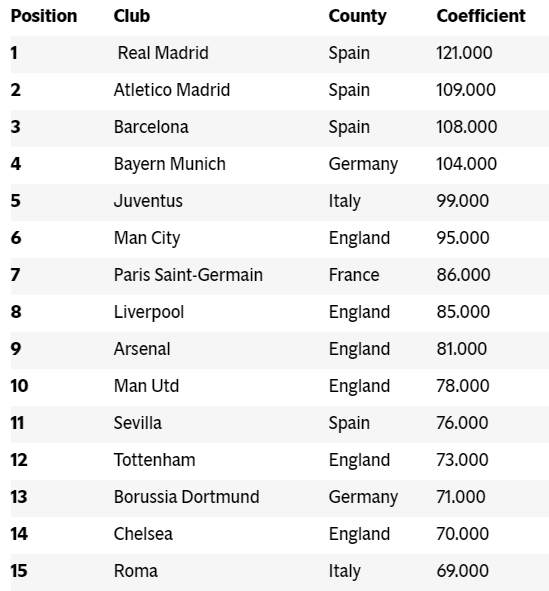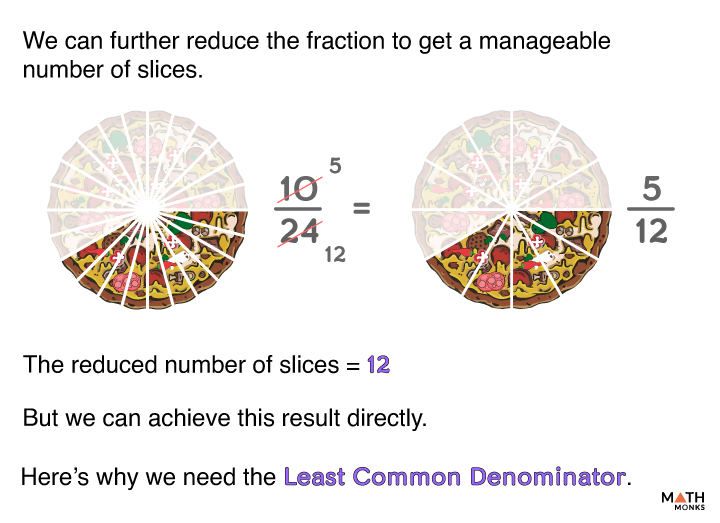
The Unseen Battlegrounds: Decoding the Latest UEFA Coefficients Ranking
In the intricate tapestry of European club football, where millions of fans passionately follow their teams, a silent yet relentless battle unfolds off the pitch – the fight for UEFA Coefficient points. These points, meticulously calculated and updated after every European matchday, are far more than mere statistics; they are the linchpin that determines a nation’s prestige, a league’s standing, and ultimately, a club’s access and seeding in the lucrative and prestigious UEFA Champions League, Europa League, and Europa Conference League. As the footballing calendar progresses, the "latest" UEFA coefficients are a constantly shifting barometer of power, dictating the financial flows, strategic planning, and global perception of European football.
What Exactly Are UEFA Coefficients?
Before diving into the current landscape, it’s crucial to understand the two primary types of coefficients and how they are calculated:
-
Club Coefficients: These are individual club rankings based on their performance in UEFA club competitions (Champions League, Europa League, and Europa Conference League) over the past five seasons. Points are awarded for wins (2 points), draws (1 point), and reaching specific stages of competitions (e.g., group stage qualification, knockout rounds, semi-finals, finals). A club’s coefficient for a given season is the sum of points earned in that season plus a bonus based on their association’s coefficient, ensuring a baseline for clubs from stronger leagues. The final five-year club coefficient is the sum of the points accumulated over the last five seasons.
-
National Association (Country) Coefficients: This is arguably the more critical ranking as it directly impacts how many clubs from a particular league qualify for European competitions and at what stage they enter. A nation’s coefficient is calculated by summing the total points earned by all its clubs in UEFA competitions in a given season, divided by the number of clubs that participated from that association in the Champions League and Europa League (or now, all three competitions). Like club coefficients, the national association coefficient is based on a five-year rolling average. This means a strong performance by even one club can significantly boost its nation’s standing, but consistent strong performances across multiple clubs are necessary for sustained high rankings.
The five-year rolling average is vital. It provides stability, preventing a single exceptional or poor season from drastically altering a nation’s or club’s standing. However, it also means that a nation or club must consistently perform over half a decade to maintain or improve its position, creating a continuous cycle of competition.
Why Do They Matter So Much? The Impact Unveiled
The implications of these rankings are profound, affecting every level of European football:
For National Associations (Leagues):
- Qualification Slots: The most significant impact is on the number of guaranteed berths a league receives in the Champions League, Europa League, and Europa Conference League. For instance, the top-ranked associations (currently England, Spain, Italy, Germany) typically receive four direct spots in the Champions League group stage, while lower-ranked nations might only get one spot, starting from early qualifying rounds.
- Entry Stage: A higher ranking means clubs from that nation enter competitions at a later stage, bypassing arduous and risky qualifying rounds. Direct group stage entry provides immense financial benefits and guarantees high-level competition.
- Prestige and Attractiveness: A high national coefficient signals a strong, competitive league, making it more attractive for top players, coaches, and sponsors, further reinforcing its status.
For Clubs:
- Seeding in Draws: A high club coefficient ensures a club is seeded in draws for the group stages and knockout rounds, meaning they avoid facing other top-ranked teams early in the competition. This significantly increases their chances of progressing.
- Financial Rewards: Direct qualification for group stages (especially the Champions League) guarantees tens of millions of euros from UEFA prize money, broadcasting rights, and increased gate receipts. This financial injection is crucial for club development, player acquisition, and overall sustainability.
- Reputation and Brand Value: Consistent European success, reflected in a high coefficient, elevates a club’s global brand, attracts more fans, and strengthens its commercial appeal.
The Current Landscape: A Snapshot of Power (as of early 2024/2025 season considerations)
While exact real-time numbers fluctuate with every match, the broad strokes of the "latest" UEFA coefficients show a clear hierarchy and ongoing trends.
National Association Rankings (The Dominant Forces):
- England (Premier League): Has firmly established itself at the top, driven by the consistent excellence of its ‘Big Six’ clubs (Manchester City, Arsenal, Liverpool, Manchester United, Chelsea, Tottenham) and even other teams like Newcastle or Brighton making strong European runs. Their deep runs in all three competitions, particularly the Champions League, have cemented their position.
- Spain (La Liga): Historically dominant, Spain remains a powerhouse thanks to Real Madrid’s unparalleled success, coupled with strong performances from Barcelona, Atlético Madrid, and Sevilla (especially in the Europa League). While their lead over Italy has narrowed, they remain a formidable force.
- Italy (Serie A): Has enjoyed a significant resurgence in recent seasons, with multiple teams (Inter, Milan, Napoli, Juventus, Roma, Fiorentina, Atalanta, Lazio) making deep runs across all three competitions, including several finalists in the UCL, UEL, and UECL. This collective effort has seen them close the gap on Spain and pull ahead of Germany.
- Germany (Bundesliga): Consistently strong, primarily due to Bayern Munich’s perennial success and the solid performances of Borussia Dortmund, RB Leipzig, and Bayer Leverkusen. While they have slipped to fourth, their top clubs remain highly competitive.
- France (Ligue 1): Largely carried by Paris Saint-Germain’s deep Champions League runs. The challenge for France is often the lack of consistent support from other clubs reaching the latter stages, though teams like Marseille, Lyon, and Lille occasionally contribute valuable points.
Beyond the Big Five: The Contenders and the Challengers:
- Netherlands (Eredivisie): A consistent challenger, thanks to Ajax’s previous Champions League semi-final run and the regular contributions of PSV Eindhoven and Feyenoord. They are often battling Portugal for the crucial sixth spot, which can offer an extra Champions League berth.
- Portugal (Primeira Liga): Benefiting from the consistent European presence of Benfica and FC Porto, Portugal remains a strong contender, often trading places with the Netherlands.
- Belgium (Jupiler Pro League): Clubs like Club Brugge and Genk have shown capability, but often struggle for the depth needed to consistently challenge the top tiers.
- Scotland (Scottish Premiership): Celtic and Rangers have provided significant points, especially through Europa League and Conference League runs, showcasing the potential for smaller leagues to climb.
Key Trends in the Latest Rankings:
- English Hegemony: The Premier League’s dominance is undeniable, fueled by immense financial power allowing them to attract and retain top talent. Their depth means even if one or two clubs falter, others step up.
- Italian Resurgence: Serie A’s collective effort has been remarkable. This is a testament to improved tactical approaches and investment across multiple clubs, not just a single dominant force.
- The "Gap" Remains: Despite the efforts of nations like the Netherlands and Portugal, the financial and competitive gap between the "Big Five" leagues and the rest of Europe remains substantial, making it incredibly difficult for smaller nations to break into the top tier of qualification slots.
- The Europa Conference League’s Impact: This competition, designed to give more clubs from lower-ranked nations European experience and revenue, has also become a crucial battleground for coefficient points. Success here can significantly boost a nation’s ranking, as seen with clubs from Belgium, Turkey, Greece, and even England.
The Financial Engine and The Cycle of Success
The coefficient rankings are inextricably linked to the financial health of clubs and leagues. Direct entry into the Champions League group stage can be worth upwards of €50 million just in participation fees and prize money, before factoring in gate receipts, sponsorship bonuses, and increased market value. This enormous sum allows clubs to:
- Invest in Squads: Buy better players, offer higher wages, and retain existing talent.
- Improve Infrastructure: Modernize stadiums, training facilities, and academies.
- Expand Global Reach: Fund international marketing and fan engagement initiatives.
This creates a powerful, self-reinforcing cycle: high coefficient -> better access and seeding -> more prize money -> better squad -> more European success -> higher coefficient. Breaking into this cycle for clubs and nations outside the established elite is one of the biggest challenges in modern European football.
Looking Ahead: The Swiss Model and Future Implications
The upcoming format change for the UEFA Champions League, adopting a "Swiss Model" league phase from the 2024/2025 season, will undoubtedly influence coefficient accumulation. With more matches (8 per team in the new league phase instead of 6 in the group stage), there will be more opportunities for clubs to earn points.
- Potential for More Points Overall: More matches mean more wins/draws available, potentially increasing total points for all participating clubs.
- Reinforcing the Elite: While there are more games, the top clubs are still likely to win more of them. The format might inadvertently solidify the dominance of the strongest teams, as they’ll have more chances to rack up points against a wider array of opponents.
- Increased Competition for Mid-Tier Clubs: The expanded format might offer more chances for clubs just outside the elite to earn vital points, but they will also face more top-tier opposition, making consistency even more critical.
The future of UEFA coefficients will continue to reflect the ongoing struggle for dominance, access, and financial prosperity in European football. While the "latest" rankings offer a snapshot, the underlying trends – the English ascendancy, the Italian resurgence, and the persistent challenge for the rest – will shape the beautiful game for years to come. The unseen battle for points will remain as compelling and crucial as the on-field drama, defining who plays where, against whom, and for how much.



